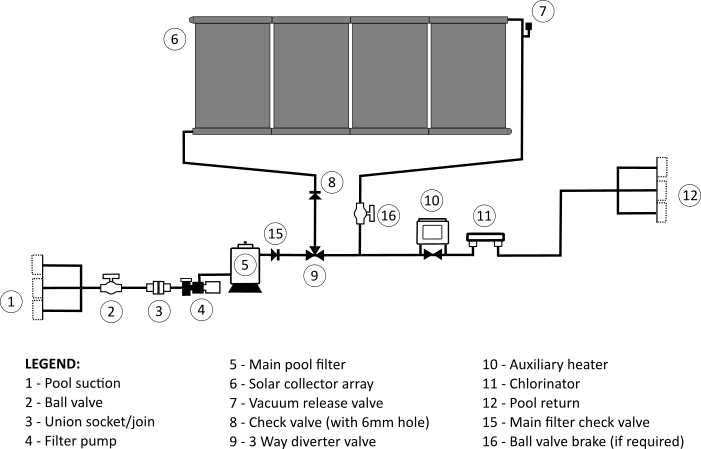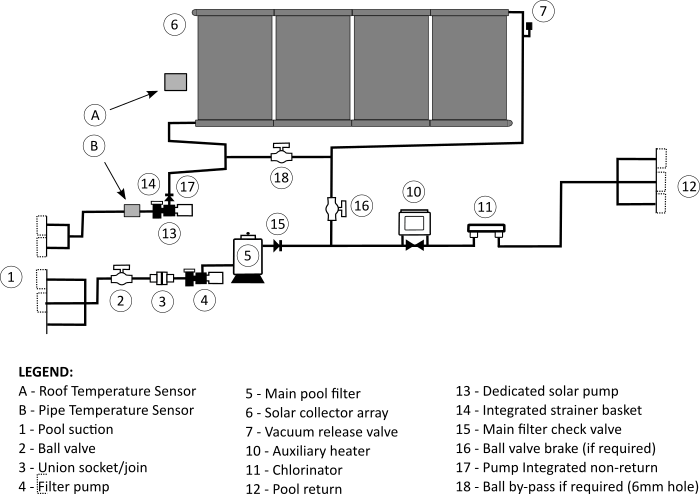Solar Pool Heater Valves
Solar Pool Heater Valves
Solar pool heaters can have many different types of valves and it can get confusing, here is a run down of the different types and their functions.

Figure 1. Example manual pool heating system plumbing diagram

Figure 2. Example independent pool heating system plumbing diagram
Non-return Valve (17)
For an independent type system (or booster type systems, see the system setups page), there should either be a separate non-return valve (17) with a 6mm hole drilled in the flap after the pump, or the pump itself should have an integrated non-return flap installed in the outlet. The function of this non-return valve is crucial. It prevents water from rushing back when the pump stops. This serves two purposes: first, it prevents the pump's rotor from spinning backwards, which could potentially loosen it; second, it protects the collectors from experiencing negative pressure fluctuations. While a vacuum release valve typically prevents this on the return line side, PVC strips still experience a pressure differential across them. Without this non-return valve on the supply side, the strips would be subjected to significant negative pressure, even with a vacuum release installed on the return line. This valve should not be perfectly sealed, allowing some water to drain back into the pool. All solar pool heating systems are referred to as drain-back systems, although not all the water will fully drain from them.
Air Sealing Non-return Valve (17)
Some systems have difficulty priming, and the only solution is to install a special air-sealing non-return valve (17). This is a precision-engineered, spring-loaded valve that prevents water from flowing back through the suction line, ensuring that your suction lines remain primed at all times. Note that this is a last-resort strategy for fixing priming issues and is not typically recommended. Even these non-return valves can allow a small amount of water to pass (at pressure) if a twig or similar debris becomes lodged in the seal. Therefore, these non-return valves require fine strainers to be installed upstream and must be cleaned regularly to increase reliability.
Vacuum Release Valve (7)
Solar pool heater must have a vacuum release valve (7) on the return line, installed on or just off the roof. As the pump stops and the system wants to drain back, the function of this valve is to open on negative pressure and allow air to enter the collectors so that the weight of the water pulling internally on system components does not collapse collectors and PVC piping up on the roof (especially black PVC piping which can get soft in the sun). A solar pool heating system will not last long if this critical valve was not installed.
Combination Vacuum/Air Release Valve
Some solar pool heating systems encounter an issue where, due to a particular arrangement of suction and return pipes, hot collectors that normally stagnate in the sun during summer without issue (when the pool is already at temperature) will become hot enough that the increased air pressure in the collectors pushes water from the suction line back into the pool. This can evacuate at lot of water from the suction line. A self-priming pump may then struggle to prime if it has to clear a large amount of air in the suction line during startup. In this case, you can install an air release valve on the inlet side, which will release any positive pressure air generated during stagnation. It is rare that this valve is required.
3-Way Ball Valve (9)
For manual systems, a 3-way ball valve (9) is installed on the main filter line. The purpose of this valve is to divert water to the solar collectors. This valve can be either manual or motorized and controlled by a specialized controller. It is recommended to install a stop on the valve to ensure it is opened just enough to allow sufficient water flow through the collectors and to slightly pressurize the vacuum release (7), but no further, to avoid over-pressurizing the collectors unnecessarily.
Ball Break Valve (16)
Some systems, especially two story installations require what's termed a break valve (16) on the return line. This is a standard PVC ball shut off valve. The function of this valve is to slow the return flow so that the vacuum release on the roof is positively pressurize during system operation. If the vacuum release is at negative pressure as the system is running, it will draw in air and you will see constant bubbling at your pool's solar return outlet(s). Note: an initial bubble purge at start up is perfectly normal.
By-Pass Valve (18)
For independent solar pool heating systems, after you install your system and start the solar pump for the first time, you will know if the pressure at the vacuum release height is positive and/or excessive, or negative. If the system pressure is excessive (as shown on the supplied pressure gauge installed on the return line) then you will need what's called a by-pass valve (18). The purpose of this valve is to short circuit the flow to the roof and hence to drop the pressure up on the roof to near zero at the vacuum release. A by-pass valve is preferred to the pressure limiting valve we discuss next as it won't put back pressure on you pump.
Pressure Limiting Valve
Some systems have a PVC ball shut off valve installed after the pump outlet (not shown on plumbing diagrams), this is to pair back excessive flow to the collectors if the pump was oversized and the pressure up on the roof cannot be limited sufficiently using a by-pass valve (18) discussed previously. Flow is decreased until the pressure at the vacuum release up on the roof is reduced sufficiently. Note, this valve will put back pressure on your pump; ideally if you require a pressure limiting valve you really should consider getting a lower power pump.





